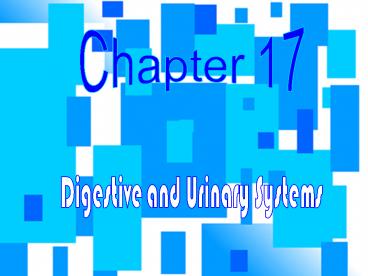Digestive and Urinary Systems - PowerPoint PPT Presentation
1 / 12
Title:
Digestive and Urinary Systems
Description:
Functions of the Digestive System ... The nervous system triggers the digestive process ... The following health behaviors will keep your digestive system healthy: ... – PowerPoint PPT presentation
Number of Views:194
Avg rating:3.0/5.0
Title: Digestive and Urinary Systems
1
Chapter 17
Digestive and Urinary Systems
2
Health Standards
10.2.2 Describe the role of government agencies
in regulating advertising claims related to
health. 10.2.3 Describe the effectiveness,
accessibility, and inclusiveness of a health
program in supporting individual and public
health. 10.3.6 Develop strategies to improve or
maintain personal, family, and community
health. 10.4.1 Analyze the influences of family,
peers, and community have on the health and
health behavior of individuals.
3
Functions of the Digestive System
- Digestion includes both mechanical and chemical
processes. - The mechanical portion involves chewing, mashing,
and breaking food into smaller pieces. - The chemical process involves digestive juices
that change food into simpler substances.
- Digestion- the mechanical and chemical breakdown
of foods for use by the bodys cells. - Absorption- the passage of digested food from
the digestive tract into the cardiovascular
system. - Elimination- the expulsion of undigested food or
body wastes.
- The Nervous and cardiovascular systems also
play a major role in the digestion process. - The nervous system triggers the digestive
process - Nutrients are carried through the body by the
cardiovascular system.
4
Structures of the Digestive System
- The digestive process begins in the mouth which
consists of the - teeth break down the food into smaller pieces.
This process is called Mastication. - The salivary glands produce the first
digestive juices in the digestive process. - The tongue forms chewed food into a size and
shape that can be swallowed.
5
Structures Continued
- The Esophagus
- A Muscular tube about 10 inches long, that
connects the pharynx and the stomach. - Food moves through the esophagus, stomach, and
intestines. - Peristalsis a series of involuntary muscle
contractions that moves food through the
digestive tract.)
- The Stomach
- A hollow saclike organ enclosed in a muscular
wall. - The stomach contains many gastric juices
(secretions from the stomach lining that contain
hydrochloric acid and pepsin, an enzyme that
digest protein.) - Holds food for further digestion. As food is
digested in the stomach, it is converted into
chyme (a creamy fluid mixture of food and gastric
juices.)
- The Pancreas, Liver, and Gallbladder
- The pancreas creates enzyme that break down the
carbohydrates, fats, and proteins in food. - The liver produces another digestive juice called
bile (yellow-green bitter fluid important in the
breakdown and absorption of fats.) - Between meals the bile is stored in the
gallbladder.
6
Structures Part C
- The Small Intestine
- It is 20 to 23 feet in length and 1 inch in
diameter. - Consists of three parts the duodenum, the
jejunum, and the ileum. - Contains millions of fingerlike projections
called villi.
- The Large Intestine
- It is 2.5 inches in diameter and 5 to 6 feet in
length. - Absorbs water, vitamins, and salts.
- Eliminates wastes.
7
Health Behaviors and the Digestive System
- Taking care of your digestive system begins with
the choices you make about the food that you eat.
The following health behaviors will keep your
digestive system healthy - Follow a well balanced diet that includes a
variety of foods. - Wash your hands before preparing a meal and
before eating. - Eat slowly and chew food thoroughly.
- Drink at least eight 8-ounce glasses of water
each day. - Avoid using food as a way of dealing with your
emotions.
8
Functional Problems of the Digestive System
- The following are problems of the digestive
system - Indigestion
- Heartburn
- Gas
- Constipation
- Nausea
- diarrhea
9
Structural Problems of the Digestive System
- Problems Include
- Gallstones
- Appendicitis
- Gastritis
- Lactose Intolerance
- Peptic Ulcer
- Cirrhosis
- Crohns Disease
- Colon Cancer
- Colitis
- Hemorrhoids
- Tooth Decay
10
Functions of the Urinary System
Ureters- tubes that connect the kidneys to the
bladder.
Urine- Liquid waste
material. Urethra- the tube that leads from the
bladder to the outside of the body.
Bladder- hollow muscular organ that acts like a
reservoir for urine. Nephrons- The functional
units of the kidneys.
11
Health Behaviors and the Urinary System
- Here are several factors that can help your urine
system - Drink at least eight 8-ounces of aqua each day
- Eat a well balanced diet
- Practice good hygiene
- Have regular medical checkups
- Avoid caffeine
12
Problems of the Urinary System
- Kidney Problems
- Nephritis
- Kidney Stone
- Uremia
- Cystitis- an inflammation of the bladder.
- Urethritis- the inflammation of the urethra.
- Hemodialysis- a technique in which an artificial
kidney machine removes waste products from the
blood.
- Kidney Failure
- Hemodialysis
- Peritoneal dialysis
- Kidney transplant































